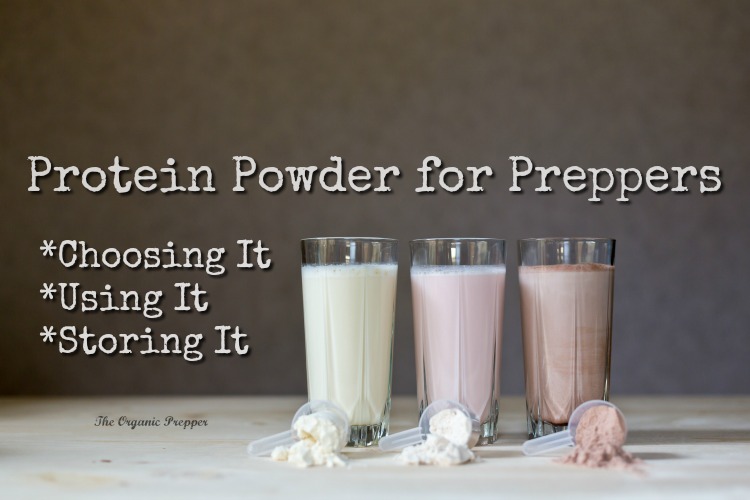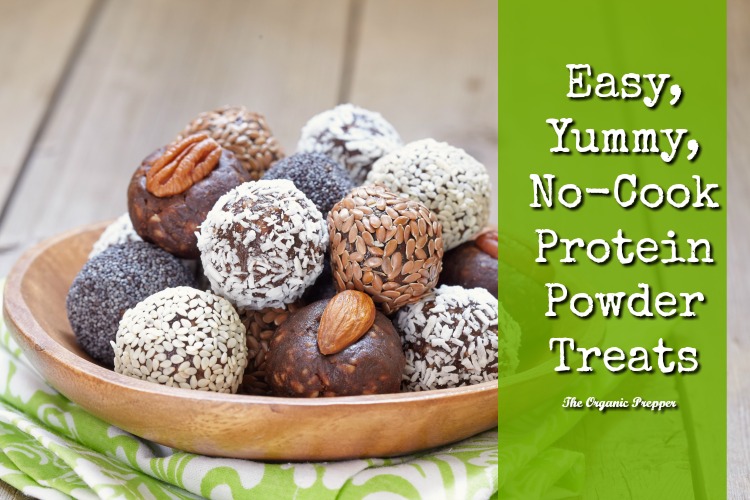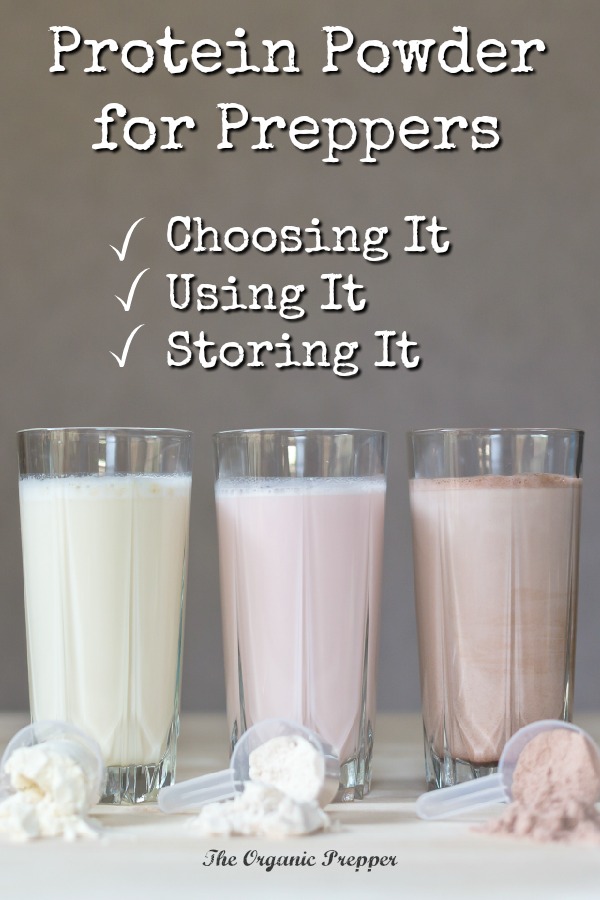If you're new here, you may want to subscribe to my RSS feed. Thanks for visiting!

Protein powder isn’t just for bodybuilders. It can be a great addition to your prepper stockpile (or even to your diet right now!)
A lot of folks aren’t getting enough protein for good health. If we ate the 10 servings of fruits and vegetables that are recommended along with a sufficient amount of protein, we’d be eating almost constantly. But we often end up reaching for unhealthy snacks to fill us up that do nothing to meet our nutritional needs.
The benefits of protein powder
A good quality protein powder can turn a “snack” into a nutritional motherlode at the touch of a blender. In fact, you don’t even have to have a blender if all you want is the protein part. There are shaker cups with a little whisk ball inside that will thoroughly mix most good protein powders with nothing but people power. ( I like the ones with at least 28 ounces for more shaker space.)
It can also play a part if you have a family member who isn’t eating for some reason. Perhaps they’re sick and maybe they just don’t have an appetite due to the stress of the situation. A shake loaded with protein powder, nutrient-rich fruits, and a base of milk (dairy or non-dairy), can provide everything a person needs with no chewing required.
Some powders have additional vitamins and minerals added in, or you can also get vitamin powders to go into your shake. A green superfood powder adds the goodness of fruits and vegetables on the go (perfect for an emergency) and liquid trace minerals are also available. You can also add a dropper of any type of herbal tincture that you happen to be taking.
How long can you store protein powder?
An unopened tub of protein powder lasts for about two years so this isn’t something to plop in the bunker for 20 years. It should be rotated into your kitchen pantry and enjoyed now, just like any other shorter term product.
Protein powder is one of the few things that is best stored in the package it comes in. (Assuming it comes in one of those plastic canisters with a sealed inner top.) If it comes in a bag, you may want to put that bag into another mylar bag, but avoid opening the original bag until you’re ready to use it. Exposure to oxygen is the kiss of death for a longer-term freshness for this product. Keep it in a cool, dry, dark place.
After the best-by date, protein powder can begin to lose its potency because the lysine begins to break down. The flavor may also begin to degrade. However, you can still use it unless it smells off. Never use a protein powder that smells rancid. (Duh. But I have to say it so that no one drinks rancid protein powder and says, “But Daisy said I could drink it forever and ever.”)
Protein powder isn't just for bodybuilders. It can be a great addition to your prepper stockpile!Click To TweetWhat kind of protein powder?
All protein powders are not created equally. Some of the ones with garish colors and outlandish claims are nothing but chemical bombs and should be strictly avoided. I also avoid any products that contain soy. The higher quality ones are more expensive but very worthwhile.
My very favorite brand is Naked. It is free of additives and is nothing but pure, clean ingredients. At first glance, the product seems outrageously expensive, but this is because it only comes in larger sizes (like 5 pounds). However, if you’re going to use it, per serving, it works out to a lower price than most high-quality products at only $1.11 per serving.
Naked is available in many varieties for nearly any dietary need:
- Unflavored Whey
- Rice Protein
- Less Naked Vanilla, Strawberry, or Chocolate (these are sweetened with coconut sugar and flavored with real vanilla, strawberry, and cocoa – a sample pack is available)
- Chocolate PB (peanut protein)
- Pea Protein
- Goat Milk Protein
Other good brands are
When looking for a protein powder, I check the following:
- How is it sweetened? If it’s with aspartame or sucralose, pass it by. Natural cane sugar is better than something artificial, but coconut sugar or stevia are the best choices.
- Where does the protein come from? If you are lactose intolerant, of course, a whey or casein protein will be bad news for you. Hemp protein has an earthy flavor some people strongly dislike in a fruity shake, but the unflavored one isn’t bad in a savory dish. Pea protein and egg protein are very light-tasting. This is all based on your personal preference.
- Does it have a bunch of extra ingredients promising exaggerated benefits? If those ingredients are completely unidentifiable, you may want to pass this one over. The idea here is to boost your nutrition, not to drink the equivalent of vanilla Doritos.
- How much protein does one serving contain? Ideally, you want a product that contains 15 grams of protein at the minimum. Powder from animal products like egg or dairy will generally have closer to 25 grams of protein.
How do you use it?
Here are several ways that protein powder can work for you and your family.
- Get some protein into your picky kids. (Or adults for that matter.) If you have a family member who seems only interested in existing on macaroni and cheese or mashed potatoes, an unflavored protein powder can add a boost of growth-inducing protein to an otherwise nutritionally barren meal. This one contains whey and this one is dairy-free in case you have family members who are lactose intolerant.
- Add it to those low-protein, just-add-water meals. If you are a person who generally consumes a significant amount of protein, eating those meals is going to sap your normal energy. A couple of scoops of unflavored protein powder (you don’t want chocolate in your enchilada rice dish) stirred in at the end can increase your protein intake without changing the flavor of the food.
- Use it for kids with braces. Every time my daughter gets her braces tightened, she ends up being unable to chew for several days. I make her thick, delicious shakes with frozen fruit and Nearly Naked Vanilla Whey powder to give her an “ice-creamish” treat that is still highly nutritious. This is also good for people who have had dental work or oral surgery.
- It’s speedy and healthy. Rushing out the door? Don’t get tempted by the empty calories of the pastry shop in the lobby. Blend up a quick shake loaded with fruit and protein powder to power you through until your next meal.
- It travels well. Measure single servings out into the snack-sized ziplock bags and store those inside a double zip bag. Use one of the shaker cups I mentioned above to mix your protein powder with water for immediate gratification and nutrition.
Some quick tips about making the perfect shake
Want delicious protein shakes? Read on.
- Use frozen fruit. If you use frozen fruit instead of the fresh fruit in the fridge, your shake will have a thick, frozen consistency very much like ice cream. It makes for an absolutely delicious treat and keeps you away from high sugar grocery store concoctions.
- Use juice for the base. If you juice, use your fresh pressed juice for the base of a shake. Throw in an avocado for thickness and add a scoop of vanilla protein powder for a nutrient-dense drink.
- Make your own frozen coffee beverage. You can also use some cold coffee and mix it with chocolate or vanilla powder and some ice cubes for a much healthier version of the frozen coffee beverages sold at Starbucks.
- Make a decadent float. The health of this depends on your choices. If you get regular grocery store soda pop, this isn’t very good for you. But if you go with something like Zevia (a low-calorie soda sweetened with stevia) while this isn’t something you should have every day, you can concoct a pretty delicious root beer or orange dreamsicle “float.” Simply replace the liquid in your shake with the flavor of your choice, add a couple of scoops of vanilla protein powder, and some ice. Zap it in the blender and you’re left with something so yummy it will rival any ice cream shop concoction.
Don’t limit yourself to drinking it.
As mentioned above, the unflavored version can be mixed into all sorts of low protein foods. Try a scoop in:
- Pasta dishes
- Creamy soups
- Baked goods (you’ll want to use this to replace some of the flour in equal parts)
- Mashed potatoes
- Foods with creamy sauces
For best results (aside from the baked goods), stir the powder in after you’ve finished heating the food, right before serving.
You can also make a few tasty treats from protein powder. Go HERE for a handful of recipes to get your imagination flowing. (Most of them are completely no-cook!)
Do you ever use protein powder?
Is protein powder part of your stockpile? What is your favorite thing to make with it? Share your ideas in the comments below.

















We use protein shakes in our house as a replacement for my ice cream addiction. Instead of using milk, we use coconut cream from a can (not the yukky stuff they sell in a carton), since coconut is so important to get in your diet. Thanks for all that you share. I read your blog every day.
Good timing on this informative article. I am trying to shop protein drinks, but I really didn’t know what to look for other than NO SOY and they all seem to have Soy and Whey. Thank you for giving the no Soy options too. Other sites seem to think Soy is fine and don’t understand my aversion to it. I appreciate the help.
I use a whey protein powder from MyProtein. I have used it for a number of years as an after workout drink. I generally use milk and add a raw egg to the mix. I tried GN, but their pricing was just too hokey.
My go to is Nature’s Bounty by Optimal Solutions because it mixes well in a shaker cup with plain water or cold coffee. It contains both whey and soy protein, but although I have a mild intolerance to dairy it is well tolerated by me. It also has additional vitamins, fiber and probiotics. Best of all, it is sweetened with stevia so it’s low in carbs and my mother likes it. (Sometimes she can be a picky eater. ;))
I need to have 4 servings a day to keep weight on, and this has been a concern of mine. Right now I keep about 6 days worth, which is nothing. This is going to help immensely, thank you Daisy.
How long will a good protein powder last if unopened in the freezer?
It differs for all of them. I would look at the best by date and add maybe a year. It’s tricky, particularly if you are storing whey protein or anything with fats. I wouldn’t recommend stashing away gallons and gallons of powder, unfortunately, due to the shelf life. I would get stuff to use now and get ahead by 2-4 containers. Sorry that I can’t give you a more clear answer.
I am on a Keto diet so I make pancakes from mostly sour cream and ricotta cheese and eggs. I always throw in 2 tbsp of protein powder as I use only 1 tbsp of flour for 5 pancakes. Yum!
Thanks for this info, Daisy